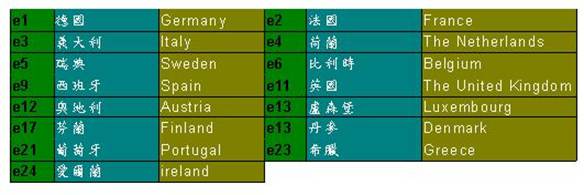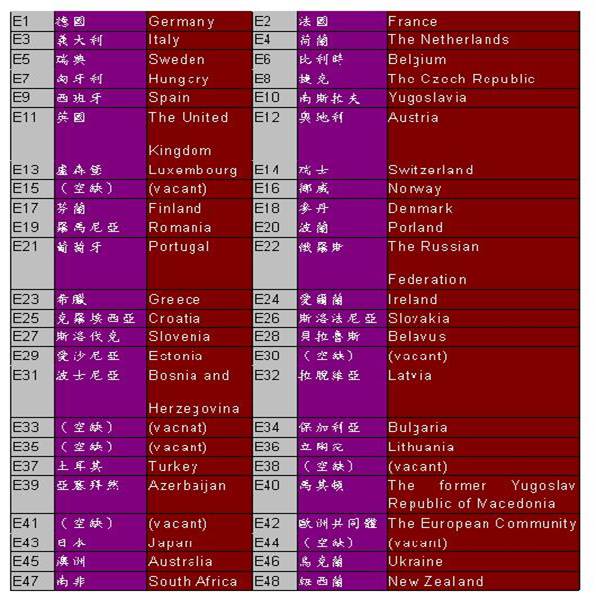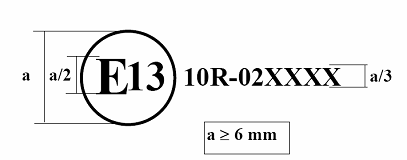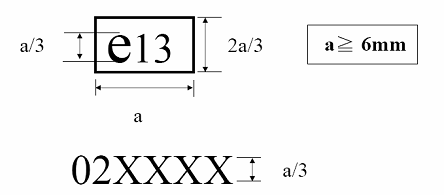E/e-mark
What is E/e-mark?
According to the EC Directive and the ECE Regulation, the import of European motor vehicles and their spare parts must comply with the relevant regulations to maintain the basic safety requirements of driving and environmental protection. The product has an E/e-mark verification mark indicating that the product complies with the relevant specifications of the country in which it is issued.
Why do we need to mark?
All relevant Member States shall incorporate the regulations into the regulations of the country in accordance with the specifications of the above-mentioned organizations to ensure that the products related to the sale and use of the motorcycles by the manufacturers meet the basic safety and environmental requirements. If the product has regulatory requirements, it must be tested and certified and properly labeled. If the product is not marked E/e-mark, it is prohibited to be sold on the market in the member countries.
 |
 |
| E represents products in compliance with the regulations of the Economic Commission for Europe, number (4) represents the country (the Netherlands), and currently the Economic Commission for Europe has 56 Member States. | e represents products in compliance with EU directives, number (4) represents countries (Netherlands) and currently has 27 member states in the EU. |
E/e-mark difference
| Mark | E meark | e mark |
| Name | Directive | Regulation |
| Formulating unit | EC | ECE |
| ● Origin | European trade, political alliance | United Nations affiliated organization |
| ● Headquarters | Brussels | Geneva |
| ● Membership acquisition | Need to be a member of the EU member state | United Nations members are free to join |
| ● Official language | Language of all Member States | French, English, Russian |
| ● Applicable area | EU member states | Europe, and other regions (such as Japan, Turkey, Australia, etc.) |
| ● Member States’ acceptance of norms | Mandatory / all Articles need to be accepted | Non-mandatory / can choose the appropriate Articles for the country |
| ● The Whole Vehicle Type Approval (WVTA) | Yes | No |
Products for E/e-mark verification
- Vehicle products: working machines or vehicles that can be driven on general roads such as locomotives, passenger cars, trucks, and buses.
Vehicle components: lights, horns, light bulbs, rearview mirrors, automotive glass, tires, brakes, etc.
Accessories: helmets, child safety chairs, anti-theft devices, car audio, hands-free headsets, mobile phone chargers, car accessories, etc.
Non-road mobile machinery engines : A mechanical engine that is not a vehicle such as a chain saw, a lawn mower, a stacker, or an agricultural machinery.
E/e-mark qualification method
The product should be considered in the design phase, and the product verification test should be performed by an authorized technical service to confirm compliance with relevant regulations. After passing the test, submit the test report together with the technical documents and other application materials, and apply for an E/e-mark certificate from any national transportation department of the organization.
If a product that does not comply with the regulations is sold in the organization of the member country, the manufacturer or seller is responsible. The manufacturing is located in its territory and its responsibility is attributed to the manufacturer; the overseas is the sales agent of the country. Before the issuance of the certificate, the national transportation department of each organization must confirm whether the factory is a legally registered manufacturer and has a relevant quality management system to ensure the consistency of future volume products. The ISO 9000 series certificate is the best basis for providing the above proof; if it is not available, the competent authorities will perform a factory evaluation check on the manufacturer.
1. Test Standard: 72/245/EEC, 95/54/EC, Chapter 8
2. Main Testing items:
(1) EMI test – Broadband Test, Narrowband Test
(2) EMS testing – depending on product characteristics
Note: If the product will affect driving safety, you need to add more EMS test items.
3. Issuing unit:
E/e Mark Introduction (2006/25/EC)


e-Mark member of EEC
 xrepresents the number of the Member State
xrepresents the number of the Member State

E-Mark’s ECE member states
 xrepresents the number of the Member State
xrepresents the number of the Member State

4.Main differences between the certification units:
(1) Agent: According to each member country, whether or not a local agent is required.
(2) Production Evaluation (C.O.P): This assessment is performed on the applicant’s production location in accordance with the respective cycle of each Member State, and the relevant fees must be paid by the applicant. Or if the product finds any problems or complaints from customers in Europe, it will conduct the so-called quantity product tracing evaluation from time to time to the applicant’s production location.
5. Certification fee:
(1) a. EMI testing and certification fees: depending on the product.
b. EMS additional test costs are additional.
(2) First application for factory evaluation fee: depending on the product.
(3) Test + certification lead time: 4 weeks.
6. Preparation:
(1) 2~3 sets of test samples (provided peripherals; under complete test conditions).
(2) Product specifications, electrical specifications and wiring diagrams.
(3) If there is a series of certifications, please provide a table of differences between products.
(4) Application forms and authorization letters of each certification unit.
(5) Nameplate label/warning label.
(6) Other relevant requirements.
E/e Mark application process:
| Items | Process | Required Information | Form/Certificate | attachment | |
| Before the project open | 1 | Quote | Client Name and Product Name / Model / Specification | Application form, catalogue or instruction manual or image | |
| Confirm whether there is ISO9001/TS or E mark certification before | ISO9001 Certificate Or E/e mark COP report |
||||
| When the project open | 2 | Prepayment | Quotation return | Signed quotation | |
| Reserve certification font number(three days after opening the project) | Company name address / product name / model name / test order or standard | ||||
| After the project open | 3-a | COP | Factory inspection documents and the documents that require to be attached | COP Questionnaire | |
| Initial COP Surveillance | |||||
| Quality Control System Projects and Test Instruments and Programs | Quality Control Plan or Inspection Plan and Test Procedure | ||||
| After the project open | 3-b | No need cop | Have already done E mark certificate before | Declaration of additional certification unit | |
| After the project open | 4 | Testing | Samples | According to the requirements of the engineer | |
| Information of product | Technical files such as circuit diagrams, product images, etc., please refer to the file requirements list. | ||||
| After the project open | 5 | Carry out testing | |||
| After the project open | 6 | Write a test report | |||
| After the project open | 7 | testing report
Submit for review |
|||
| Project closed | 8 | Pay the final payment, get the certificate | |||
E/e MARK Label:
(1) E-mark marking requirement according to ECE-R10

(2) e-mark marking requirement according to 95/54/EC

